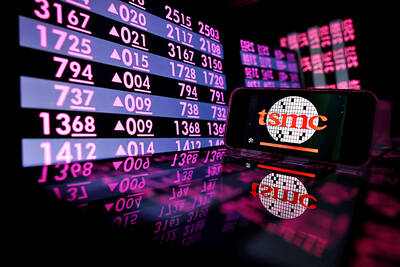All eyes are to be on the Bank of Japan (BOJ) when it sets policy tomorrow, as Governor Kazuo Ueda continues to inch toward ending the world’s last negative interest-rate regime.
It is unlikely to happen this time. People familiar with the matter said that Japanese authorities are not in a hurry to move while they await hard evidence of sustainable inflation.
BOJ watchers can therefore be expected to scour the statement and comments by Ueda for hints on the outlook for wage hikes and the prospects for better pay spurring spending and demand-led inflation.

Photo: Reuters
Any bullish rumblings would underpin growing expectations that the BOJ would raise its rate no later than April, as predicted by two-thirds of economists surveyed by Bloomberg earlier this month.
“We have argued that Ueda would move gingerly toward exiting the stimulus program he inherited, using a policy review and deliberate signaling to prepare the market well in advance. This process has clearly begun — but is a long way from over,” Bloomberg Economics senior Japan economist Taro Kimura said.
On the surface, the BOJ’s mission might seem a little awkward after the US Federal Reserve telegraphed rate cuts next year.
It is important to remember that the BOJ has no intention of introducing restrictive settings. If and when Ueda ends the negative rate, the governor would emphasize that policy remains broadly stimulative.
However, there has been increased speculation it could happen next month after Ueda said his job could become “more challenging” from year-end and following Deputy Governor Ryozo Himino’s hypothesis for what might happen if indeed rates go positive.
All Nippon Asset Management Co chief strategist Chotaro Morita believes that the BOJ is considering lifting negative interest rates next month.
The BOJ focus on spring wage negotiations means that it will raise rates “around January to April no matter what anyone thinks,” said Morita, who was ranked No. 1 for bonds in the Nikkei Veritas analyst rankings for six consecutive years through 2022. “It is clear that the BOJ is considering lifting the policy in January” to ensure it has flexibility in the future, he said.
The central bank is in the midst of its last monetary policy meeting of this year, with its decision due tomorrow. A majority of forecasters expect the BOJ would end the world’s last negative rate regime by April, according to a Bloomberg survey.

Taiwan Semiconductor Manufacturing Co (TSMC, 台積電) yesterday said that its investment plan in Arizona is going according to schedule, following a local media report claiming that the company is planning to break ground on its third wafer fab in the US in June. In a statement, TSMC said it does not comment on market speculation, but that its investments in Arizona are proceeding well. TSMC is investing more than US$65 billion in Arizona to build three advanced wafer fabs. The first one has started production using the 4-nanometer (nm) process, while the second one would start mass production using the

When an apartment comes up for rent in Germany’s big cities, hundreds of prospective tenants often queue down the street to view it, but the acute shortage of affordable housing is getting scant attention ahead of today’s snap general election. “Housing is one of the main problems for people, but nobody talks about it, nobody takes it seriously,” said Andreas Ibel, president of Build Europe, an association representing housing developers. Migration and the sluggish economy top the list of voters’ concerns, but analysts say housing policy fails to break through as returns on investment take time to register, making the

‘SILVER LINING’: Although the news caused TSMC to fall on the local market, an analyst said that as tariffs are not set to go into effect until April, there is still time for negotiations US President Donald Trump on Tuesday said that he would likely impose tariffs on semiconductor, automobile and pharmaceutical imports of about 25 percent, with an announcement coming as soon as April 2 in a move that would represent a dramatic widening of the US leader’s trade war. “I probably will tell you that on April 2, but it’ll be in the neighborhood of 25 percent,” Trump told reporters at his Mar-a-Lago club when asked about his plan for auto tariffs. Asked about similar levies on pharmaceutical drugs and semiconductors, the president said that “it’ll be 25 percent and higher, and it’ll

CHIP BOOM: Revenue for the semiconductor industry is set to reach US$1 trillion by 2032, opening up opportunities for the chip pacakging and testing company, it said ASE Technology Holding Co (日月光投控), the world’s largest provider of outsourced semiconductor assembly and test (OSAT) services, yesterday launched a new advanced manufacturing facility in Penang, Malaysia, aiming to meet growing demand for emerging technologies such as generative artificial intelligence (AI) applications. The US$300 million facility is a critical step in expanding ASE’s global footprint, offering an alternative for customers from the US, Europe, Japan, South Korea and China to assemble and test chips outside of Taiwan amid efforts to diversify supply chains. The plant, the company’s fifth in Malaysia, is part of a strategic expansion plan that would more than triple